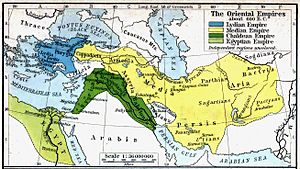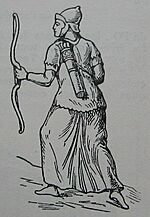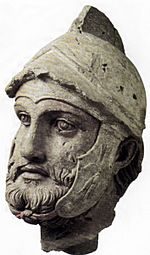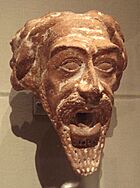Parthia facts for kids
Quick facts for kids Parthia
𐎱𐎼𐎰𐎺
|
|
|---|---|
| Historical region of Iran | |
 The region of Parthia within the empire of Medes, c. 600 BC; from a historical atlas illustrated by William Robert Shepherd |
|
| Capital | Nisa |
| History | |
|
• Establishment of the Parthian Empire
|
247 BC |
|
• Fall of the Parthian Empire
|
224 AD |
| Today part of | Iran and Turkmenistan |
Parthia (Old Persian: 𐎱𐎼𐎰𐎺 Parθava) was an ancient region in the northeastern part of what is now Iran. It was a very important area in ancient history.
For a long time, Parthia was part of bigger empires. First, it was conquered by the Medes in the 7th century BC. Then, Cyrus the Great added it to the Achaemenid Empire in the 6th century BC. After Alexander the Great's conquests in the 4th century BC, it became part of the Seleucid Empire.
Later, Parthia became the homeland and power base for the Parni people. They founded the Parthian Empire, which ruled a vast area from 247 BC to 224 AD. Even after the Parthian Empire fell, the region remained important. The Sasanian Empire, which came after, kept some of the powerful Parthian families as part of their government.
Contents
What's in a Name?

The name "Parthia" comes from the Latin word Parthia. This word itself came from the Old Persian word Parthava. This was how the Parthians, an Iranian group, referred to themselves. It meant "of the Parthians."
During the time when Greek culture was very strong (the Hellenistic period), Parthia was also called Parthyaea. Later, during the Sasanian period, it was known as Pahlaw in Middle Persian. Islamic writers later called it Pahla or Fahla. These names mostly referred to the western parts of the Parthian region in Iran.
Where Was Parthia Located?
The original area of Parthia is in northeastern Iran and partly in southern Turkmenistan. It was surrounded by natural features. The Kopet Dag mountains were to its north, and the Dasht-e Kavir desert was to its south.
Parthia shared borders with other regions:
Over time, the exact borders of Parthia changed. During the time of the Arsacid rulers (who founded the Parthian Empire), Parthia and Hyrcania were often managed together. This meant Hyrcania was sometimes seen as part of Parthia.
Later, during the early Sasanian period, Parthia was in the central part of the Iranian plateau. It bordered Pars to the south and Media to the northwest. By the late Sasanian era, Parthia had grown to include central and north-central Iran, and even some western areas.
Parthia's Story Through Time
Under the Achaemenid Empire

Parthia first appeared as a political region in the lists of provinces (called "satrapies") of the Achaemenid Empire. Before this, the people of the region were likely under the rule of the Medes. Ancient Assyrian texts from the 7th century BC mention a land called Partakka or Partukka, which might have been the same area.
After Cyrus the Great defeated the Median king Astyages, Parthia was one of the first regions to accept Cyrus as their ruler. This loyalty helped Cyrus secure his eastern borders. It allowed him to start his first big military campaigns, like the one against Sardis.
When Darius I took over the Achaemenid throne, the Parthians joined the Median king Phraortes in a revolt against him. Hystaspes, who was the Achaemenid governor of Parthia and Darius I's father, managed to stop this revolt around 522–521 BC.
The first mention of Parthia by Iranians themselves is in the Behistun inscription of Darius I. This inscription, from about 520 BC, lists Parthia among the nearby provinces. The main city for administration might have been Hecatompylus. The Greek historian Herodotus also listed Parthians as subjects of the Achaemenids.
At the Battle of Gaugamela in 331 BC, where Darius III fought Alexander the Great, a Parthian army unit was led by Phrataphernes. He was the Achaemenid governor of Parthia at that time. After Darius III's defeat, Phrataphernes gave his province to Alexander when the Macedonian arrived in 330 BC. Alexander then reappointed Phrataphernes as governor.
Under the Seleucid Empire
After Alexander the Great died, Parthia became a province of the Seleucid Empire in 323 BC. Nicanor was appointed as its governor. Later, in 320 BC, Parthia was given to Philip, who had been the governor of Sogdiana.
In 316 BC, Stasander, a ruler under Seleucus I Nicator, became governor of Parthia. For the next 60 years, different Seleucid rulers were appointed to govern the province.
In 247 BC, after the death of Antiochus II, Ptolemy III took control of the Seleucid capital. This caused a lot of uncertainty for the Seleucid dynasty. Taking advantage of this, Andragoras, the Seleucid governor of Parthia, declared that Parthia was now independent. He even started making his own coins.
Around the same time, a man named Arsaces became the leader of the Parni people. The Parni were an eastern-Iranian group from a river valley southeast of the Caspian Sea. Since Parthia had broken away from the Seleucid Empire, Andragoras lost military support. Around 238 BC, Arsaces and his brother Tiridates led the Parni to invade Parthia. They took control of the northern part of the region, called Astabene.
Soon after, the Parni took over the rest of Parthia and killed Andragoras. The Seleucids tried to get Parthia back. Seleucus II failed, but Antiochus III managed to recapture some territory in 209 BC from Arsaces II, who was Arsaces' successor. Arsaces II agreed to become a vassal (a ruler who owes loyalty to a more powerful king). It wasn't until Phraates I, a grandson or grand-nephew of Arsaces II, that the Arsacids (the ruling family of the Parni) began to truly assert their independence again.
The Rise of the Parthian Empire


From their home base in Parthia, the Arsacid rulers eventually expanded their control to include most of Greater Iran. They also set up related royal families in Armenia, Iberia, and Caucasian Albania. Even though the Arsacid kings didn't always have their capital in Parthia, their main power came from there. They relied on the military and financial support of the powerful Parthian noble families. In return, these families received large areas of land in the newly conquered territories. The Parthian nobles then ruled these areas like local governors. Some of the largest cities they controlled included Kuchan, Semnan, Gorgan, Merv, Zabol, and Yazd.
By about 105 BC, these Parthian noble families became so powerful that they often went against the king. This eventually helped lead to the downfall of the Arsacid dynasty.
From around 130 BC onwards, Parthia faced many attacks from nomadic tribes like the Sakas, the Yuezhi, and the Massagetae. The Arsacid kings personally led the defense against these attacks, even when there were bigger threats from the Seleucids or Romans in the west. Defending the empire against the nomads cost the lives of kings Phraates II and Artabanus I.
The Roman general Crassus tried to conquer Parthia in 52 BC but was badly defeated at the Battle of Carrhae. Caesar was planning another invasion when he was killed in 44 BC. A long series of wars between Rome and Parthia followed.
Around 32 BC, a civil war started when a man named Tiridates rebelled against Phraates IV. This was probably with the help of the nobles who Phraates had treated harshly. The revolt was successful at first but failed by 25 BC. In 9/8 AD, the Parthian nobles managed to put their chosen king, Vonones, on the throne. However, Vonones controlled the money too strictly, so he was replaced by Artabanus II. Artabanus II was likely a Parthian nobleman, not from the Arsacid royal family. He tried to strengthen his power, but he couldn't control the regions where the powerful Parthian provincial rulers had too much influence.
By the 2nd century AD, the frequent wars with Rome and the nomads, along with fighting among the Parthian nobles, had made the Arsacids weak. They could no longer defend their territories. The empire broke apart as many regions declared independence or were conquered by others. Finally, the Arsacids were defeated by the Persian Sasanids, who were once a smaller kingdom from southwestern Iran, in April 224 AD.
Under the Sasanian Empire
Parthia was probably the first region conquered by Ardashir I after he defeated Artabanus IV. This shows how important the province was to the founder of the Sasanian dynasty. Some Parthian nobles continued to resist Sasanian rule for a while, but most quickly switched their loyalty to the Sasanids.
Several families who claimed to be descended from the old Parthian noble families became a special group in the Sasanian Empire known as the "Seven houses." However, it's believed that five of these families probably weren't truly Parthian. They created these family histories to make their families seem more ancient and important.
Parthia remained important throughout the 3rd century. In his inscription at the Ka'ba-ye Zartosht, Shapur I listed Parthia as the second most important province after Pars. The Abnun inscription describes the Roman invasion of 243/44 AD as an attack on Pars and Parthia. Since the Romans never went beyond Mesopotamia, "Pars and Parthia" might have been used to mean the entire Sasanian Empire. Parthia was also the second province chosen to settle Roman prisoners of war after the Battle of Edessa in 260 AD.
Language and Stories
The Parthians spoke the Parthian language, which was a northwestern Iranian language. We don't have much Parthian writing from before the Sasanian period. It seems they didn't write down many stories.
However, the Parthians had a very active tradition of oral minstrel-poets. These poets were called gosan. This word is still used today in many Iranian languages and especially in Armenian (gusan). These minstrels were part of everyday life. They entertained kings and common people alike. They would tell stories and sing poems about their patrons, connecting them to mythical heroes and rulers. These Parthian heroic poems are mostly known through later Persian writings, like Firdausi's famous Shahnameh.
Most of the written Parthian language we have comes from nearly three thousand ostraca (pieces of pottery with writing on them) found at Nisa. These seem to have been from a wine storage area. A few other examples of written Parthian have been found outside Parthia, including a land-sale document from Avroman (in Iran) and more ostraca and graffiti from Dura-Europos in Syria.
The Arsacid kings of Parthia didn't seem to use the Parthian language in their official writings until later. It first appeared on their coins during the reign of Vologases I (51–58 AD). We know the language was widely used because of early Sasanian writings. The declarations of the early Persian kings were written in both their native Middle Persian and in Parthian.
Old poems known as fahlaviyat mostly come from areas that were considered part of Parthia during the Islamic period. These poems sound like oral stories and might have continued the traditions of the Parthian minstrels.
Parthian Society
Large cities existed in Parthia as early as 1000 BC, not just from the time of the Achaemenids or Seleucids. However, most of society was rural. It was dominated by powerful landowners who had many serfs, slaves, and other workers. There were also communities of free peasants.
During the Arsacid period, Parthian society was divided into four main groups (for free people):
- At the top: Kings and their close family members.
- Next: Lesser nobles and priests.
- Then: Merchants and lower-ranking government workers.
- At the bottom: Farmers and herders.
We don't know much about the Parthian economy, but farming was likely the most important part of it. Significant trade began around 114 BC with the establishment of the Silk road. At that time, Hecatompylos became an important trading hub.
Important Parthian Cities
- Nisa (also called Nissa or Nusay), or Mithradātkert, was an early capital of the Parthian Empire (around 250 BC). It was located on a major trade route, west of modern-day Ashgabat in Turkmenistan. Nisa had impressive buildings, including a large two-story hall in the Greek style and temple complexes used by the early Arsacid rulers. During the reign of Mithridates I of Parthia (around 171 – 138 BC), it was renamed Mithradatkirt ("fortress of Mithradates").
- Merv (modern-day Mary) was another important Parthian city.
- Asaak
- Gurgan
- Hecatompylos
See also
 In Spanish: Partia para niños
In Spanish: Partia para niños
- Adur Burzen-Mihr
- Greater Khorasan
- Khwarasan
- List of Parthian kings
- Pahla
- Parthian shot
- Parthians






